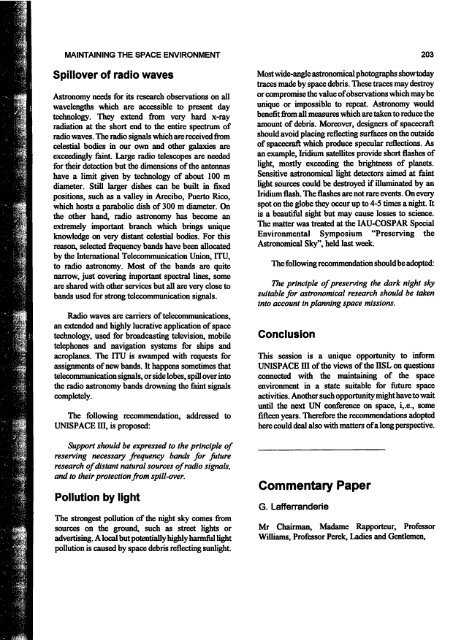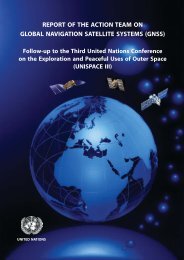Proceedings of the Workshop - United Nations Office for Outer ...
Proceedings of the Workshop - United Nations Office for Outer ...
Proceedings of the Workshop - United Nations Office for Outer ...
- No tags were found...
You also want an ePaper? Increase the reach of your titles
YUMPU automatically turns print PDFs into web optimized ePapers that Google loves.
MAINTAINING THE SPACE ENVIRONMENT 203Spillover <strong>of</strong> radio wavesAstronomy needs <strong>for</strong> its research observations on allwavelengths which are accessible to present daytechnology. They extend from very hard x-rayradiation at <strong>the</strong> short end to <strong>the</strong> entire spectrum <strong>of</strong>radio waves. The radio signals which are received fromcelestial bodies in our own and o<strong>the</strong>r galaxies areexceedingly fa int. Large radio telescopes are needed<strong>for</strong> <strong>the</strong>ir detection but <strong>the</strong> dimensions <strong>of</strong> <strong>the</strong> antennashave a limit given by technology <strong>of</strong> about 100 mdiameter. Still larger dishes can be built in fixedpositions, such as a valley in Arecibo, Puerto Rico,which hosts a parabolic dish <strong>of</strong> 300 m diameter. On<strong>the</strong> o<strong>the</strong>r hand, radio astronomy has become anextremely important branch which brings uniqueknowledge on very distant celestial bodies. For thisreason, selected frequency bands have been allocatedby <strong>the</strong> International Telecommunication Union, ITU,to radio astronomy. Most <strong>of</strong> <strong>the</strong> bands are quitenarrow, just covering important spectral lines, someare shared with o<strong>the</strong>r services but all are very close tobands used <strong>for</strong> strong telecommunication signals.Radio waves are carriers <strong>of</strong> telecommunications,an extended and highly lucrative application <strong>of</strong> spacetechnology, used <strong>for</strong> broadcasting television, mobiletelephones and navigation systems <strong>for</strong> ships andaeroplanes. The ITU is swamped with requests <strong>for</strong>assignments o f new bands. It happens sometimes thattelecommunication signals, or side lobes, spill over into<strong>the</strong> radio astronomy bands drowning <strong>the</strong> feint signalscompletely.The following recommendation, addressed toUNISPACE III, is proposed:Support should be expressed to <strong>the</strong> principle o freserving necessary frequency bands fo r futureresearch o f distant natural sources o f radio signals,and to <strong>the</strong>ir protection from spill-over.Pollution by lightThe strongest pollution <strong>of</strong> <strong>the</strong> night sky comes fromsources on <strong>the</strong> ground, such as street lights oradvertising. A local but potentially highly harmful lightpollution is caused by space debris reflecting sunlight.Most wide-angle astronomical photographs show todaytraces made by space debris. These traces may destroyor compromise <strong>the</strong> value <strong>of</strong> observations which may beunique or impossible to repeat. Astronomy wouldbenefit from all measures which are taken to reduce <strong>the</strong>amount <strong>of</strong> debris. Moreover, designers <strong>of</strong> spacecraftshould avoid placing reflecting surfaces on <strong>the</strong> outside<strong>of</strong> spacecraft which produce specular reflections. Asan example, Iridium satellites provide short flashes <strong>of</strong>light, mostly exceeding <strong>the</strong> brightness <strong>of</strong> planets.Sensitive astronomical light detectors aimed at faintlight sources could be destroyed if illuminated by anIridium flash. The flashes are not rare events. On everyspot on <strong>the</strong> globe <strong>the</strong>y occur up to 4-5 times a night. Itis a beautiful sight but may cause losses to science.The matter was treated at <strong>the</strong> IAU-COSPAR SpecialEnvironmental Symposium “Preserving <strong>the</strong>Astronomical Sky”, held last week.The following recommendation should be adopted:The principle o f preserving <strong>the</strong> dark night skysuitable fo r astronomical research should be takeninto account in planning space missions.ConclusionThis session is a unique opportunity to in<strong>for</strong>mUNISPACE III <strong>of</strong> <strong>the</strong> views o f <strong>the</strong> IISL on questionsconnected with <strong>the</strong> maintaining <strong>of</strong> <strong>the</strong> spaceenvironment in a state suitable <strong>for</strong> future spaceactivities. Ano<strong>the</strong>r such opportunity might have to waituntil <strong>the</strong> next UN conference on space, i,.e., somefifteen years. There<strong>for</strong>e <strong>the</strong> recommendations adoptedhere could deal also with matters <strong>of</strong> a long perspective.Commentary PaperG. LafferranderieMr Chairman, Madame Rapporteur, Pr<strong>of</strong>essorWilliams, Pr<strong>of</strong>essor Perek, Ladies and Gentlemen,
















